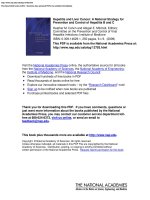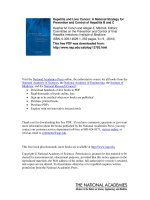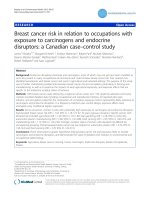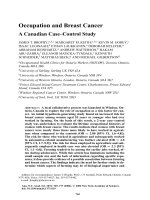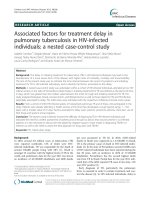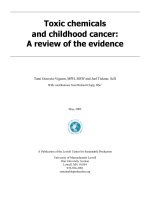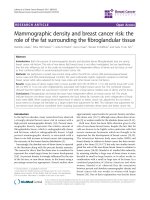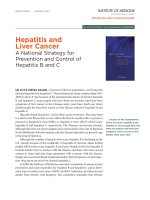Occupation and Breast Cancer: A Canadian Case–Control Study docx
Bạn đang xem bản rút gọn của tài liệu. Xem và tải ngay bản đầy đủ của tài liệu tại đây (82.08 KB, 13 trang )
Occupation and Breast Cancer
A Canadian Case–Control Study
JAMES T. BROPHY,
a,b,c
MARGARET M. KEITH,
a,b,c
KEVIN M. GOREY,
c
ISAAC LUGINAAH,
d
ETHAN LAUKKANEN,
e
DEBORAH HELLYER,
a
ABRAHAM REINHARTZ,
a
ANDREW WATTERSON,
b
HAKAM
ABU-ZAHRA,
f
ELEANOR MATICKA-TYNDALE,
c
KENNETH
SCHNEIDER,
f
MATTHIAS BECK,
g
AND MICHAEL GILBERTSON
b
a
Occupational Health Clinics for Ontario Workers (OHCOW), Toronto, Ontario,
Canada M6A 3B6
b
University of Stirling, Stirling UK FK9 4LA
c
University of Windsor, Windsor, Ontario, Canada N9B 3P4
d
University of Western Ontario, London, Ontario, Canada N6A 3K7
e
Prince Edward Island Cancer Treatment Centre, Charlottetown, Prince Edward
Island, Canada CIA 8T5
f
Windsor Regional Cancer Centre, Windsor, Ontario, Canada N8W ZX3
g
University of York, York, UK YO10 5DD
ABSTRACT:Alocal collaborative process was launched in Windsor, On-
tario, Canada to explore the role of occupation as a risk factor for can-
cer. An initial hypothesis-generating study found an increased risk for
breast cancer among women aged 55 years or younger who had ever
worked in farming. On the basis of this result, a 2-year case–control
study was undertaken to evaluate the lifetime occupational histories of
women with breast cancer. The results indicate that women with breast
cancer were nearly three times more likely to have worked in agricul-
ture when compared to the controls (OR = 2.80 [95% CI, 1.6–4.8]).
The risk for those who worked in agriculture and subsequently worked
in automotive-related manufacturing was further elevated (OR = 4.0
[95% CI, 1.7–9.9]). The risk for those employed in agriculture and sub-
sequently employed in health care was also elevated (OR = 2.3 [95%
CI, 1.1–4.6]). Farming tended to be among the earlier jobs worked, of-
ten during adolescence. While this article has limitations including the
small sample size and the lack of information regarding specific expo-
sures, it does provide evidence of a possible association between farming
and breast cancer. The findings indicate the need for further study to de-
termine which aspects of farming may be of biological importance and
Address for correspondence: James T. Brophy, Ph.D., 171 Kendall, Point Edward, Ontario, Canada
N7V 4G6. Voice: 519-337-4627; fax: 519-337-9442.
e-mail:
Ann. N.Y. Acad. Sci. 1076: 765–777 (2006).
C
2006 New York Academy of Sciences.
doi: 10.1196/annals.1371.019
765
766 ANNALS NEW YORK ACADEMY OF SCIENCES
to better understand the significance of timing of exposure in terms of
cancer risk.
K
EYWORDS:breast cancer; occupation; environment; farming; Canada
INTRODUCTION
The lifetime risk for breast cancer among Canadian women is approximately
1in9.Over the past 30 years, there has been a 25% increase. The majority
of cases cannot be explained by the currently known or suspected risk factors.
Family history of breast cancer, particularly with respect to having two or more
relatives with breast cancer and mutation of the BRCA1 and BRCA2 gene, can
explain less than 10% of breast cancer cases.
1
Factors that increase cumula-
tive estrogen load have been found to increase risk. There is evidence of an
association with diet, alcohol use, body mass index, reproductive history, age,
physical activity, and socioeconomic status.
2
The recent increase in incidence
may be linked to the combination of identified risk factors and those requiring
further study, such as occupational and environmental exposures.
3
Increasing
evidence suggests that synthetic chemicals, particularly those that mimic estro-
gen (xenoestrogens), may increase risk by acting as endocrine disruptors.
4
Such
exogenous chemicals include organochlorine pesticides, polycyclic aromatic
hydrocarbons, organic solvents, and plastics.
5–8
Animal bioassays have iden-
tified over 200 chemical substances that trigger breast cancer.
9
Another factor
that has implications for research into the possible role of occupational and
environmental exposures is the multistage developmental process that charac-
terizes cancer. Toxic insults, either singular or in combination, may influence
the initiation, promotion, and progression of carcinogenesis. Both dose and
timing of exposure may be important in terms of risk. It has been suggested
that there are critical moments in breast development when the emerging cells
may be more susceptible to tumor initiation and progression.
1,4
There may
be particular vulnerability during periods of morphological and biochemical
change, that is, beginning during gestation and continuing through puberty to
time of first pregnancy and possibly throughout the reproductive years.
9
There
may also be a combined impact from exposure to carcinogens and hormonally
active substances. It has been suggested that genotoxic agents, in conjunction
with estrogen, can affect cell repair mechanisms thereby allowing damaged
cells to reproduce.
1
There is a significant gap in our understanding of work-related exposures
and breast cancer risk.
10
Many substances shown to induce breast cancer
in experimental mammals exist in high concentrations in occupational set-
tings.
11
In spite of the continuing increase in the incidence of cancer in
Canada and the existence of carcinogens in occupational environments, there
remain no registries or systematic methods to record the occupational his-
tories of cancer patients in general, nor breast cancer patients in particular.
BROPHY et al.: OCCUPATION AND BREAST CANCER 767
The failure to document lifetime occupational histories and correspond-
ing workplace exposures results in an underestimation of occupationally
related cancers and a corresponding lack of substantive prevention-related
activity.
12
METHODS
Ahypothesis-generating study, entitled Computerized Recording of Occu-
pations Made Easy (CROME), was conducted between 1995 and 1999 through
a collaborative effort of the Windsor Regional Cancer Centre (WRCC), the On-
tario Occupational Disease Panel (ODP), and the Occupational Health Clin-
ics for Ontario Workers (OHCOW). The study area, Windsor-Essex, Ontario,
Canada, has extensive manufacturing and agricultural activity. The CROME
study gathered the occupational histories of 299 breast cancer cases, which
were then compared to 237 women with cancers other than breast or ovary.
It found an elevated risk for breast cancer among women 55 years of age or
younger who had ever worked in farming (OR = 9.05 [95% CI, 1.06–77.43]).
13
There were a number of important limitations to the study including: small sam-
ple size; the use of hospital-based controls; and the failure to adequately capture
data regarding potential confounders beyond those of age, socioeconomic sta-
tus, and body mass index. Moreover, detailed occupational descriptions were
absent.
On the basis of the results from CROME, a second population-based case–
control study, entitled Lifetime Occupational Histories Record (LOHR), was
undertaken in 2000 in the same geographical study area to further explore pos-
sible associations between breast cancer and occupation in general and farm-
ing in particular. LOHR had several improvements over the previous study:
it used randomly selected community controls rather than hospital controls;
it captured more detailed occupational descriptions; and it collected data for
a broader range of potential confounders. Over a 2.5-year period, all female
patients treated at the Windsor Regional Cancer Centre (WRCC) with histo-
logically confirmed new incident primary breast cancer were invited to par-
ticipate. None of the cases had participated in the previous study. The medical
records department screened breast cancer patients to confirm pathology and
date of diagnosis. A letter was mailed to each eligible patient outlining the
study and was followed up by a telephone call. Five hundred sixty-four eli-
gible breast cancer patients participated in the study. Three patients declined
participation, resulting in a 99% plus response rate. Community controls were
chosen at random using city directory software
14
and were recruited by letter
and a scripted follow-up telephone call to improve response rate among the
less literate. The information provided to potential controls about the research
did not specify a particular focus on occupational or environmental risk fac-
tors for breast cancer; the research was simply referred to as a “Risk History
768 ANNALS NEW YORK ACADEMY OF SCIENCES
Study.” The controls were approximately matched by age and by geographical
area. Five hundred ninety-nine eligible community controls participated out
of 1146 contacted representing a response rate of 52.2%. All subjects, signed
informed consents and each was offered a $20 stipend as compensation for their
time.
A comprehensive lifetime history questionnaire was administered to each
subject by a trained interviewer. The questionnaire gathered data regard-
ing height and weight (body mass index), marital status, income, education,
age of menarche, menstrual history, pregnancy and breast-feeding history,
menopausal status, hormone use, family breast cancer history, residential his-
tory by three-digit postal code, hobbies, and complete occupational history
including age at the start and end of each job. The questionnaire also included
questions about a range of occupational exposures: asbestos, man-made min-
eral fibers, dusts, second-hand tobacco smoke, engine exhaust, other smoke
or particulate, metal-working fluids, solvents, paints, strippers, and pesticides.
Agricultural workers were also asked about chemical exposures. Subjects’ re-
call regarding specific agents proved to be limited and much of the exposure
information was deemed unreliable or was missing. As a result, data regarding
exposure to specific agents was not included in the analysis. Jobs were cate-
gorized by coders, who were blind as to the case–control status of the subject
data, using National Occupational Classification (NOC)
15
codes and the North
American Industrial Classification System (NAICS).
16
The NOC codes, which
provided more specificity than the NAICS, were included in the analysis. Simi-
lar or related occupations were grouped together to provide adequate statistical
power.
FINDINGS
Included in the LOHR analysis were data from 564 female breast cancer
cases and 599 female controls. The statistical program SPSS Version 10 was
used to conduct a three-step multivariate analysis to test the hypothesis of
a possible association between breast cancer risk and occupation. Logistic
regression analysis was used to calculate odds ratios and their 95% confidence
intervals.
17
In the initial step, cases and controls who had ever been employed
in agriculture were compared while controlling for duration of employment
using five ordinal variables: none, 0.5–5 years, 6–10 years, 11–20 years, and
21 or more years. Due to small sample size duration did not reach statistical
significance for any of the specific periods.
In the next step, the odds ratios for the independent variables (e.g., farm-
ing) indicate the effect of each variable, after adjusting for covariates, on the
probability of developing breast cancer. The following ordinal covariates were
included in the model: age at diagnosis (mean age of cases = 60.33, mean
BROPHY et al.: OCCUPATION AND BREAST CANCER 769
TABLE 1. Descriptive profile of 564 female breast cancer cases and 599 female commu-
nity controls
Breast cancer cases Community controls
Ye s % N o % Yes % No %
Ever pregnant
1
495 (43%) 65 (5.6%) 527 (45.8%) 64 (5.6)
Ever use hormone replacement 261 (22.4%) 303 (26.1%) 263 (22.6%) 336 (28.9%)
Ever smoke tobacco 249 (21.4%) 315 (27.1%) 273 (23.5%) 326 (28%)
Ever breast feed 378 (32.5%) 186 (16%) 370 (31.8%) 229 (19.7%)
Ever used oral contraceptives
2
289 (25%) 273 (23.6%) 339 (29.3%) 256 (22.1%)
Mother ever had cancer
3
125 (10.9%) 431 (37.5%) 146 (12.7%) 447 (38.9%)
Ever reside on a farm or live 253 (22.2%) 305 (26.7%) 247 (21.6%) 337 (29.5%)
within a mile of a farm
4
1
Missing cases = 12 (1%).
2
Missing cases = 6 (.5%).
3
Missing cases = 14 (1.2%).
4
Missing cases = 21 (1.8%).
age of controls = 58.64); education level; annual household income; body
mass index; number of pregnancies; years of oral contraceptive use; months
of breast feeding; years of cigarette smoking; alcohol use and marital status.
This step also included the following dichotomous covariates (T
ABLE 1): ever
pregnant; ever used hormones; ever smoked tobacco; ever breast feed; ever
used oral contraceptives; mother ever had cancer; and ever reside on a farm or
live within a mile of a farm. Number of years of residence in Essex County
was included as a continuous variable within the model.
The final step in the conditional logistic model included the major occupa-
tional groups: automotive-related manufacturing; clerical; communications;
dry cleaning; education or library; petrochemical; finance or insurance; food
processing; food service; hair dressing; manufacturing or engineering man-
agers; office professionals; skilled sales; health care; janitorial; other manu-
facturing; plastics; printing, painting, or construction; retail; social service;
textile; transportation or security; animal care; sports or arts; pest control;
postal; mining or logging; landscaping; home care; and unemployed outside
the home. In the final step of the model all the occupations interacted with
age, but only four occupations remained within the model (agriculture, retail,
and the interactions of agriculture with automotive-related manufacturing and
of agriculture with health care).
At this stage there were 1026 subjects (cases = 506; controls = 520) with
137 missing (11.8%). As shown in T
ABLE 2, the results indicate that women
with breast cancer were nearly three times more likely to have worked in
agriculture (n = 154) when compared to the controls (n = 133) (OR= 2.80
[95% CI, 1.6–4.8]). Although the individual contribution of automotive-related
770 ANNALS NEW YORK ACADEMY OF SCIENCES
TABLE 2. Logistic regression-estimated odds ratios (OR) of women ever employed in
agriculture, automotive-related manufacturing, or health care
95.0% C.I.
Odds ratio
(OR) Lower Upper
Ever worked in agriculture 2.8
a
1.6 4.8
Worked in agriculture and then 4.1
b
1.7 9.9
in automotive-related manufacturing
Worked in agriculture and then in health care 2.3
c
1.1 4.6
Worked in automotive-related 0.76 0.59 1.10
manufacturing (but never agriculture)
Worked in health care (but never agriculture) 0.85 0.62 1.17
Ever worked in retail 1.0 1.0 1.05
Age 1.0 1.0 1.02
a
Sig. = 0.0002
b
Sig. = 0.002
c
Sig. = 0 .02
manufacturing alone was not significant (OR = 0.76 [95% CI, 0.59–1.10]),
the risk for those who worked in agriculture and subsequently worked in
automotive-related manufacturing was further elevated (OR = 4.0 [95% CI,
1.7–9.9]). The individual contribution of health care alone was not significant
(OR = 0.85 [95% CI, 0.62–1.17]), however, the risk for those employed in
agriculture and subsequently employed in health care was elevated (OR = 2.3
[95% CI, 1.1–4.6]). Agricultural jobs tended to be among the first worked,
often during adolescence.
There is a modest body of literature regarding breast cancer risk in agricul-
ture, health care, and the automotive industry.
FARMING OCCUPATIONS AND BREAST CANCER RISK
While some studies of farming populations have shown an elevated risk
for breast cancer, as well as other cancers,
18–20
several large cohort stud-
ies found no elevated risk for breast cancer.
21–23
Female farmers and labor-
ers have not been as extensively studied as their male counterparts. While
most studies did not indicate specific exposures, it is plausible that agricul-
tural chemicals may play a role. There is evidence of an association between
breast cancer and some pesticides, such as dichlorodiphenyltrichloroethane
(DDT), its metabolite dichlorodiphenyldichloroethylene (DDE), polychlori-
nated biphenyls (PCBs), hexachlorobenzene, hexachlorocyclohexane, hep-
tachlor epoxide, and triazine herbicides; others are under review.
24–26
A large
number of pesticides are also hormonally active.
27
The herbicide, atrazine, for
example, is one of the most widely used agricultural chemicals. The triazine
pesticides are considered endocrine disruptors and are suspected human car-
cinogens.
28
Some agricultural chemicals, such as organochlorine pesticides,
BROPHY et al.: OCCUPATION AND BREAST CANCER 771
are persistent and bioaccumulate in the adipose tissue.
29
A case–control study
that controlled for both traditional breast cancer risk factors as well as ex-
posures among women engaged in farming, found that women who reported
being present in the fields during or shortly after pesticide application had an
increased risk of developing breast cancer (OR= 1.8 [95% CI, 1.1–2.8]).
30
Among those who reported using pesticides without protective clothing, an
increased risk of breast cancer was identified (OR = 2.0 [95% CI, 1.0–4.3]);
while women with protective clothing did not have an elevated breast cancer
risk (OR = 0.8 [95% CI, 0.4–1.8]). The researchers concluded that, while
farming may not present an elevated risk per se,farming women who were not
adequately protected from exposure to pesticides might have an elevated risk.
A Canadian study found that, among the combined pre- and postmenopausal
group, there was an increased breast cancer risk among women who had ever
been employed in fruit and vegetable farming (OR = 3.11, 90% [CI 1.24–
7.81]).
31
A recent study examining the breast cancer risk of Hispanic agricul-
tural workers in California associated three specific pesticide exposures—
chlordane, malathion, and 2,4-dichlorophenoxyacetic acid (2,4-D)—with ele-
vated breast cancer risk.
32
HEALTHCARE OCCUPATIONS AND BREAST CANCER RISK
A number of known or suspected carcinogens are present in the health-
care setting. Nurses and other healthcare workers are potentially exposed to
ionizing radiation, antineoplastic drugs, anesthetic waste gases, and viruses
possibly associated with cancer risk.
33
A number of hormonally active chemi-
cals are, or have been, used in medicine and laboratory work.
34
These include:
nonylphenol (used in detergents and plastics); ethylene oxide (a sterilant);
bisphenol A (used in polycarbonate plastics); butyl benzyl phthalate; and poly-
chlorinated biphenyls (PCBs). These substances have been shown to display
estrogenic activity in human breast cell bioassays.
35
Studies of shift work in-
volving nurses have found statistically significant increases in breast cancer
(OR = 1.6 (95% CI, 1.0–2.5)) and a relative risk (RR = 1.36 (95% CI, 1.04–
1.78)), respectively.
36,37
These elevations occurred among women who worked
night shifts over long periods. It is hypothesized that melatonin is disrupted,
thereby affecting estrogen levels. Breast cancer risk among nurses and other
healthcare workers was examined in administrative, cohort, and case-controls
studies.
38
Of 10 administrative and cohort studies, 8 found a positive asso-
ciation with breast cancer
39−46
while 2 did not.
47,48
Among six case–control
studies
31,49–53
there were mixed results. Elevated risk is generally noted in
several studies that examined breast cancer among registered hospital nurses
but these studies shared methodological limitations; most did not control for
known or suspected risk factors. Some of the findings varied depending on
772 ANNALS NEW YORK ACADEMY OF SCIENCES
which comparison group was used or whether menopausal status was exam-
ined. None controlled for specific exposures and all nurses were grouped into
one occupational category assuming that this broad title would be an appro-
priate surrogate for their exposures. In one case–control study an elevated
breast cancer risk was revealed only when the study population was separated
into occupational subgroups.
53
None of the existing studies assess timing of
exposure.
AUTOMOTIVE-RELATED MANUFACTURING OCCUPATIONS
AND BREAST CANCER RISK
Afew reports have addressed women autoworkers and risk of breast cancer.
A cohort study published in 1994 found no association between female breast
cancer and automotive manufacturing.
54
A recent study, however, found a weak
association (OR = 1.18 [95% CI, 1.02–1.35]) with soluble metal working
fluid (MWF) exposure.
55
There is wide use of chlorinated solvents in the
automotive industry and growing evidence that these chemicals may increase
breast cancer risk, possibly through endocrine disruption.
9,56
Organic solvents
have produced mammary tumors in animal studies. Organic solvents have been
detected in breast milk, subjecting the ducts to constant exposure. Interestingly,
the majority of breast tumors reside in the ductular system.
57
DISCUSSION
The LOHR study primarily found and then tested associations with spe-
cific occupations. It provides evidence of an association between farming
and breast cancer risk as well as an interactive effect between occupational
farming exposures and subsequent exposures in other occupational environ-
ments. It might be hypothesized that agents or conditions present in agricul-
tural settings initiate the breast cancer process at a vulnerable period (ado-
lescence) and that subsequent exposures to agents or conditions (e.g., shift
work) in automotive-related industry, health care, or other industries may act as
promotors.
The LOHR study had some limitations. While it attempted to gather in-
formation through the interview process about exposures, it was not able to
accurately identify specific causative agents. Unfortunately, many of the pa-
tients and community controls were not aware of or could not reliably recall
their exposures. It is possible that the actual breast cancer risk for some of
the women in the LOHR cohort, that is, those who had exposure to specific
pesticides, is even higher because the aggregation of the unexposed with the
exposed in the analysis may have diluted the findings. Such nondifferential
misclassification decreases the probability of detecting associations and tends
BROPHY et al.: OCCUPATION AND BREAST CANCER 773
to underestimate the actual risks.
58
Another limitation of the LOHR study was
the small sample size, which necessitated the grouping of occupational cate-
gories thereby increasing the risk of misclassification. There was a significant
percentage difference in the response rate of cases (99%) versus controls (52%)
raising the issue of possible recruitment or selection bias. Steps had been taken,
however, to minimize the risk of such bias. Selection of controls was made in-
dependent of the exposures of interest. Information provided about the research
did not specify a particular focus on occupational or environmental risk fac-
tors (the independent variable) for breast cancer (the dependant variable) in
order to reduce the likelihood that those interested in specific exposures would
respond.
The results of the LOHR study call for research to determine which aspects
of farming may be of biological importance. The further development of our
understanding regarding breast cancer risk and farming is an important public
health concern given the prevalence of potential pesticide exposure and disease
in rural communities. Moreover, the interaction between early and subsequent
exposures requires further study and consideration. A clearer understanding is
needed regarding the effects of farming exposures during the early periods of
life when breast tissue is most vulnerable.
A third study, entitled, Lifetime Histories Breast Cancer Research (LH-
BCR)
59,60
was initiated in 2004 to evaluate more specific exposures among
agricultural and other workers. Open-ended job description questions will pro-
vide comprehensive data for expert exposure assessment.
61–63
Estrogen and
progesterone receptor status of the tumor will be obtained from pathology
reports and included in the analysis. A larger sample size—1000 cases and
1000 controls—will provide added statistical power.
64
Such occupational and
environmental breast cancer research may ultimately serve to inform the for-
mulation of breast cancer prevention and early detection strategies. This may
be accomplished through the identification of current work practices or ex-
posures that can be modified to minimize breast cancer risk; and through the
identification of specific populations at potentially higher risk for breast cancer
from past exposures who can be then encouraged to pursue more diligent early
detection efforts. It may also encourage previously exposed women to avoid
further potentially harmful exposures. The results may also serve to shape
public health and regulatory policy regarding prevention strategies.
CONCLUSION
The LOHR study indicates that women who have a history of work in agri-
culture have an elevated risk for breast cancer. The risk for those who worked
in agriculture and were subsequently employed in health care or the automo-
tive industry is further elevated. While occupational categories in this study
serve as surrogates for exposure, it is plausible that exposure to agricultural
774 ANNALS NEW YORK ACADEMY OF SCIENCES
chemicals is a causative factor. Because many women who worked in farm-
ing began during adolescence, it is plausible that the timing of exposure is of
significance in terms of risk.
ACKNOWLEDGMENTS
The research was sponsored by the Occupational Health Clinics for On-
tario Workers (OHCOW), Windsor Regional Cancer Centre (WRCC), and
University of Windsor. Funding was provided for the Lifetime Occupational
Histories Record (LOHR) study by: the Workplace Safety and Insurance
Board Research Advisory Council; Windsor-Essex County Cancer Founda-
tion; Green Shield Foundation; and Canadian Auto Workers (CAW) union
locals. Support was provided by: Nicole Mahler, Robert Park, Jeff Desjarlais,
Kathy Mayville, Mary Cook, Janet Davis, Julie Durocher, Jeremy Garman,
Michael Lax, Rory O’Neill, Eileen Senn, Gregory Siwinski, Ann Sovan, and
Peter Infante. Funding was provided for the current Lifetime Histories Breast
Cancer Research (LHBCR) by the Canadian Breast Cancer Foundation and
the Breast Cancer Society of Canada.
REFERENCES
1. D
AVIS,D.L., D. AXELROD,L.BAILEY, et al. 1998. Rethinking breast cancer risk
and the environment: the case for the precautionary principle. Environ. Health
Perspect. 106: 523–529.
2. C
ANADIAN BREAST CANCER INITIATIVE. 2001. Summary report: review of lifestyle
and environmental risk factors for breast cancer. Health Canada (Cat. No. H39-
586/ 2001E).
3. D
AVIS,D.L., M. PONGSIRI &M.WOLFF. 1997. Recent developments on the avoid-
able causes of breast cancer. Ann. N. Y. Acad. Sci. 837: 513–523.
4. B
IRNBAUM, L.S. & S.E. FENTON. 2003. Cancer and developmental exposure to
endocrine disrupters. Environ. Health Perspect. 111: 389–394.
5. B
RUCKER-DAVIS,F.,K. THAYER &T.COLBORN. 2001. Significant effects of mild
endogenous hormonal changes in humans: considerations for low-dose testing.
Environ. Health Perspect. 109(Suppl. 1): 21–26.
6. B
ACCARELLI, A., A.C. PESATORI &P.A. BERTAZZI. 2000. Occupational and envi-
ronmental agents as endocrine disrupters: experimental and human evidence. J.
Endocrinol. Invest. 23: 771–781.
7. D
EGEN, G.H. & H.M. BOLT. 2000. Endocrine disrupters: update on xenoestrogens.
Int. Arch. Occup. Environ. Health 73: 433–441.
8. K
ENNEDY,S.2000. Endocrine disrupters: overview and a pathologist’s perspective.
Toxicol. Pathol. 28: 418–419.
9. B
RODY,J.G. & R.A. RUDEL. 2003. Environmental pollutants and breast cancer.
Environ. Health Perspect. 111: 1007–1019.
10. G
OLDBERG,M.S.&F.LABRECHE. 1996. Occupational risk factors for female breast
cancer: a review. Occup. Environ. Med. 53: 145–156.
BROPHY et al.: OCCUPATION AND BREAST CANCER 775
11. EPSTEIN, S., D. STEINMAN &S.LEVERT. 1997. Hazards in the workplaces. In the
Breast Cancer Prevention Program. S. Epstein, D. Steinman & S. Levert, Eds.:
273–296. MacMillan, USA.
12. B
ROPHY,J.2004. Occupational histories of occupational cancer patients in a Cana-
dian treatment centre and the generated hypothesis regarding breast cancer and
farming (letter). Int. J. Occup. Environ. Health 10: 116–118.
13. B
ROPHY,J., M.M. KEITH, K.M. GOREY, et al. 2002. Occupational histories of cancer
patients in a Canadian cancer treatment centre and the generated hypothesis
regarding breast cancer and farming. Int. J. Occup. Environ. Health 8: 346–
353.
14. POLK C
ITY DIRECTORY. 1999. Infotyme Software for Leamington, Windsor,
Windsor Suburban, Ontario. Multi-Dimensional Intelligence, R.L. Polk, South-
field, Michigan.
15. H
UMAN RESOURCES DEVELOPMENT CANADA. 1992. National Occupational Classi-
fication. Ottawa, Canada.
16. S
TATISTICS CANADA. 1998. North American Industrial Classification System. Ot-
tawa, Canada.
17. C
HECKOWAY, H., N. PEARCE &D.CRAWFORD-BROWN. 1989. Research Methods in
Occupational Epidemiology. Oxford Press. New York.
18. M
CDUFFIE,H.1994. Women at work: agriculture and pesticides. J. Occup. Med.
36: 1240–1246.
19. M
CDUFFIE,H.2005. Host factors and genetic susceptibility: a paradigm of the
conundrum of pesticide exposure and cancer associations. Rev. Environ. Health
20: 77–100.
20. D
AVIS,D.L., A. BLAIR &D.HOEL. 1992. Agricultural exposures and cancer trends
in developed countries. Environ. Health Perspect. 100: 39–44.
21. C
OOGAN,P.F., R.W. CLAPP &P.A. NEWCOMB, et al. 1996. Variation in female breast
cancer risk by occupation. Am. J. Ind. Med. 30: 430–437.
22. C
ANTOR, K.P., P.A. STEWART & L.A. BRINTON, et al. 1995. Occupational exposures
and female breast cancer mortality in the United States. J. Occup. Environ. Med.
37: 336–348.
23. M
ORTON,W.E. 1995. Major differences in breast cancer risks among occupations.
J. Occup. Environ. Med. 37: 328–335.
24. C
LAPP, R.W., G.K. HOWE & M.M. JACOBS. 2005. Environmental and occu-
pational causes of cancer: a review of recent scientific literature. Low-
ell Center for Sustainable Production, University of Massachusetts Lowell.
www.sustainableproduction.org
25. I
NTERNATIONAL AGENCY FOR RESEARCH ON CANCER (IARC). 2005. Monographs
on the evaluation of carcinogenic risks to humans. />26. W
ATTERSON,A.1995. Environmental and Occupational Carcinogens and Breast
Cancer: Public Health Concerns and Public Health Failures. DeMontfort Uni-
versity, Leicester, UK.
27. J
ANSSENS,J.P., E.V. HACKE,H.GEYS, et al. 2001. Pesticides and mortality from
hormone-dependent cancers. Eur. J. Cancer Prev. 10: 459–467.
28. D
ICH,J., S.H. ZAHM &A.HANBERG, et al. 1997. Pesticides and cancer. Cancer
Causes Control 8: 420–443.
29. A
RONSON, K., A. MILLER,C.WOLLCOTT, et al. 2000. Breast adipose tis-
sue concentrations of polychlorinated biphenyls and other organochlo-
rines and breast cancer risk. Cancer Epidemiol. Biol. Prevent. 9: 55–
63.
776 ANNALS NEW YORK ACADEMY OF SCIENCES
30. DUELL, E.J., R.C. MILLIKAN,D.A. SAVITZ, et al. 2000. A population-based case-
control study of farming and breast cancer in North Carolina. Epidemiology 11:
523–531.
31. B
AND,P.R., N.D. LE,R.FANG, et al. 2000. Identification of occupational cancer
risks in British Columbia. A population-based case-control study of 995 incident
breast cancer cases by menopausal status, controlling for confounding factors. J.
Occup. Environ. Med. 42: 284–310.
32. M
ILLS,P.K.&R.YANG. 2005. Breast cancer risk in hispanic agricultural workers
in California. Int. J. Occup. Environ. Health 11: 123–131.
33. P
EIPENS, L.A., C. BURNETT &T.ALTERMAN, et al. 1997. Mortality pattern among
female nurses: a 27-State Study, 1984-1990. Am. J. Pub. Health 87: 1539–
1543.
34. D
EBRUIN, L.S. & P.D. JOSEPHY. 2002. Perspectives on the chemical etiology of
breast cancer. Environ. Health Perspect. 110(Suppl 1): 119–128.
35. S
OTO, A.M., T.M. LIN,H.JUSTICIA, et al. 1992. An ‘in culture” bioassay to assess
the estrogencity of xenobiotics. In T. Colborn, Ed.: 295–309. Chemically Induced
Alterations in Sexual Development: The Wildlife/Human Connection. Princeton
Scientific Publishing. Princeton, NJ.
36. D
AVIS, S., D. MIRICK &R.STEVENS. 2001. Night shift work, light at night, and risk
of breast cancer. J. Natl. Cancer Inst. 93: 1557–1562.
37. S
CHERNHAMMER, E.S., F. LADEN,F.E. SPEIZER, et al. 2001. Rotating night shifts
and risk of breast cancer in women participating in the nurses’ health study. J.
Natl. Cancer Inst. 2001; 93: 1563–1568.
38. L
IE,J A.S. & K. KJAERHEIM. 2003. Cancer risk among female nurses: a literature
review. Eur. J. Cancer Prev. 6: 517–526.
39. P
ETRALIA, S.A., M. DOSEMECI, E.E. ADAMS, et al. 1999. Cancer mortality among
women employed in health care occupations in 24 U.S. States, 1984–1993. Am.
J. Ind. Med. 36: 159–165.
40. R
UBIN, C.H., C.A. BURNETT,W.E. HALPERIN, et al. 1993. Occupation as a risk
identifier for breast cancer. Am. J. Pub. Health 83: 1311–1315.
41. P
EIPINS, L.A., C. BURNETT,T.ALTERMAN, et al. 1997. Mortality patterns among
female nurses: a 27-State Study, 1984 through 1990. Am. J. Pub. Health 87:
1539–1543.
42. R
IX,B.A.&E.LYNGE. 1996. Cancer incidence in Danish health care workers.
Scand. J. Soc. Med. 24: 114–120.
43. S
ANKILA, R., S. KARJALAINEN,E.LAARA, et al. 1990. Cancer risk among health
care personnel in Finland. Scand. J. Work Environ. Health 16: 252–257.
44. M
ORTON,W.E. 1995. Major differences in breast cancer risks among occupations.
J. Occup. Environ. Med. 37: 328–335.
45. P
ETRALIA, S.A., W.H. CHOW,J.MCLAUGHLIN, et al. 1998. Occupational risk factors
for breast cancer among women in Shanghai. Am. J. Ind. Med. 34: 477–483.
46. P
OLLAN,M.&P.GUSTAVSSON. 1999. High-risk occupations for breast cancer in
the Swedish female working population. Am. J. Pub. Health 89: 875–881.
47. C
ALLE, E., T. MURPHY,C.RODRIGUEZ, et al. 1998. Occupation and breast cancer
mortality in a prospective cohort of US women. Am. J. Epidemiol. 148: 191–
197.
48. G
UNNARSDOTTIR,H.&V.RAFNSSON. 1995. Cancer incidence among icelandic
nurses. J. Occup. Environ. Med. 37: 307–312.
49. C
OOGAN,P.F., R.W. CLAPP,P.A. NEWCOMB, et al. 1996. Variation in female breast
cancer risk by occupation. Am. J. Ind. Med. 30: 430–437.
BROPHY et al.: OCCUPATION AND BREAST CANCER 777
50. HABEL, L.A., J.L. STANFORD,T.L. VAUGHAN, et al. 1995. Occupation and breast
cancer risk in middle-aged women. J. Occup. Environ. Med. 37: 349–356.
51. P
ETRALIA, S.A., M. DOSEMECI, et al. 1999. Cancer mortality among women em-
ployed in health care occupations in 24 U.S. States, 1984–1993. Am. J. Ind. Med.
36: 159–165.
52. Z
HENG,T.,T.R. HOLFORD, M.S. TAYLOR, et al. 2002. A case-control study of
occupation and breast-cancer risk in Connecticut. J. Cancer Epidemiol. Prev. 7:
3–11.
53. G
UNNARSDOTTIR, H.K., T. ASPELUND,T.KARLSSON, et al. 1997. Occupational risk
factors for breast cancer amongnurses. Int. J. Occup. Environ. Health 3: 254–258.
54. D
ELZELL, E., C. BEALL &M.MANCALUSO. 1994. Cancer mortality among women
employed in motor vehicle manufacturing. J. Occup. Med. 36: 1251–1259.
55. T
HOMPSON,D.,D. KRIEBEL, M.M. QUINN, et al. 2005. Occupational exposure to
metalworking fluids and risk of breast cancer among female autoworkers. Am.
J. Ind. Med. 47: 153–160.
56. H
ANSEN,J.1999. Breast cancer risk among relatively young women employed in
solvent-using industries. Am. J. Ind. Med. 36: 43–47.
57. L
ABRECHE,F.&M. GOLDBERG. 1997. Exposure to organic solvents and breast
cancer in women: a hypothesis. Am. J. Ind. Med. 32: 1–14.
58. B
LAIR, A., A. LINOS,P.A. STEWART, et al. 1993. Evaluation of risks for non-
Hodgkin’s lymphoma by occupation and industry exposures from a case-control
study. Am. J. Ind. Med. 23: 301–312.
59. B
ROPHY
,J.,M. KEITH,I.LUGINAAH, et al. 2003. Occupational histories of breast
cancer patients. 3 year research grant from Canadian Breast Cancer Research
Foundation—Ontario Chapter.
60. B
ROPHY,J.,M. KEITH,I.LUGINAAH, et al. 2003. Occupational histories of breast
cancer patients. 2 year research grant from Breast Cancer Society of Canada.
61. S
IEMIATYCKI,J.1991. Risk Factors for Cancer in the Workplace. CRC Press. Boca
Raton.
62. A
HRENS,W.&P.STEWART. 2003. Retrospective exposure assessment. In Exposure
Assessment in Occupational and Environmental Epidemiology. M. Nieuwenhui-
jsen: Ed.: Oxford University Press. Oxford.
63. J
OFFE,M.1992. Validity of exposure data derived from a structured questionnaire.
Am. J. Epidemiol. 135: 564–570.
64. S
IEMIATYCKI,J.1995. Future etiologic research on occupational cancer. Environ.
Health Perspect. 103(Suppl 8): 209–215.


